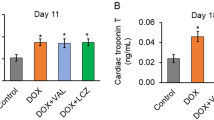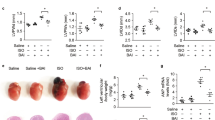Abstract
Doxorubicin-induced cardiotoxicity is related to its production of free radicals that specifically affect heart tissue because of its low antioxidant status. Monohydroxyethylrutoside (monoHER), a potent antioxidant flavonoid, is under development as a protector against doxorubicin-induced cardiotoxicity. The overexpression of high levels of superoxide dismutase (sod) protects against free radical damage in transgenic mice. Seeking alternatives besides the few cardioprotectors that are presently under investigation, the aim of the present study was to investigate the protective effect of cardiac gene transfer of CuZn–sod compared with that of the presently most promising cardioprotector monoHER against doxorubicin-induced cardiotoxic effects on neonatal rat cardiac myocytes (NeRCaMs) in vitro. NeRCaMs were infected with different multiplicity of infections (MOIs) of adenovirus encoding CuZn–sod (AdCuZn–sod). A control infection with an adenovirus vector encoding a nonrelated protein was included. The overexpression of CuZn–sod was characterized within 3 days postinfection.
For doxorubicin treatment, NeRCaMs were divided into three groups. The first group was infected with AdCuZn–sod before treatment with doxorubicin (0–50 μM). The second and third groups were treated with doxorubicin (0–50 μM) alone and with 1 mM monoHER, respectively. The LDH release and survival of treated cells were measured 24 and 48 hours after doxorubicin treatment. The beating rate was followed during the 3 days after doxorubicin (0–100 μM) treatment.
At the third day after infection with an MOI of 25 plaque-forming unit (PFU) of AdCuZn–sod/cell, the activity of CuZn–sod significantly increased (five-fold, P=.029). Higher MOI produced cytopathic effects (CPEs).
Doxorubicin alone produced significant concentration- and time-dependent reduction in NeRCaMs beating rate and survival (P<.0005). Doxorubicin (≥50 μM)-treated cells ceased to beat after 24 hours. This cytotoxicity was associated with an increase in the LDH release from the treated cells (P<.0005).
The five-fold increase in the activity of CuZn–sod did not protect against any of the cytotoxic effects of doxorubicin on NeRCaMs. In contrast, monoHER (1 mM) protected against the lethal effects of doxorubicin on the survival, LDH release and the beating rate of NeRCaMs (P<.004) during 48 hours after doxorubicin treatment. Doxorubicin-treated (≤100 μM) cells continued beating for >72 hours in the presence of monoHER.
The present study showed the lack of adenoviral CuZn–sod gene-transfer to protect myocardiocytes against doxorubicin-induced toxicity and confirms the efficacy of monoHER cardioprotection. Thus, a gene-therapy strategy involving overexpression of CuZn–sod to protect against doxorubicin-induced cardiotoxicity is not feasible with the currently available adenovirus vectors.
This is a preview of subscription content, access via your institution
Access options
Subscribe to this journal
Receive 12 print issues and online access
$259.00 per year
only $21.58 per issue
Buy this article
- Purchase on Springer Link
- Instant access to full article PDF
Prices may be subject to local taxes which are calculated during checkout





Similar content being viewed by others
Abbreviations
- MonoHER :
-
7-monohydroxyethylrutoside
- sod :
-
superoxide dismutase
- NeRCaMs :
-
neonatal rat cardiac myocytes
- AdCuZn–sod :
-
adenovirus encoding human CuZn–sod
- pfu :
-
plaque-forming unit
- MOI :
-
multiplicity of infection
- LDH :
-
lactate dehydrogenase
- μM :
-
micromol
- CPE :
-
cytopathic effects
- MTT :
-
3-(4,5-dimethylthiazol-2-yl)-2,5-diphenyltetrazolium bromide
References
Goeptar AR, Te Koppele JM, Lamme EK, et al. Cytochrome P-450 2B1-mediated one-electron reduction of adriamycin: a study with rat liver microsomes and purified enzymes. Mol Pharmacol. 1993;44:1267–1277.
Goeptar AR, Groot EJ, Scheerens H, et al. Cytotoxicity of mitomycin C and adriamycin in freshly isolated rat hepatocytes: the role of cytochrome P450. Cancer Res. 1994;54:2411–2418.
Minotti G . Adriamycin-dependent release of iron from microsomal membranes. Arch Biochem Biophys. 1989;268:398–403.
Van Acker SABE, Boven E, Kuiper K, et al. Monohyroxyethylrutoside, a dose dependent cardioprotective agent, does not affect the antitumor activity of doxorubicin. Clin Cancer Res. 1997;3:1747–1754.
Van Acker FAA, Van Acker SABE, Kramer K, et al. MonoHER protects against chronic doxorubicin-induced cardiotoxicity when administered only once per week. Clin Cancer Res. 2000;6(4):1337–1341.
Koning J, Palmer P, Franks CR, et al. Cardioxane-ICRF-187. Towards anticancer drug specificity through selective toxicity reduction. Cancer Treat Rev. 1991;18:1–19.
Van Acker SABE, Van den Berg D, Tromp MNJL, et al. Structural aspects of the antioxidant activity of flavonoids. Free Rad Biol Med. 1996;20:331–342.
Van Acker SABE, Van Balen GP, Van den Berg D, et al. Influence of iron chelation on the antioxidant activity of flavonoids. Biochem Pharmacol. 1998;56:935–943.
Keizer HG, Pinedo HM, Schuurhuis GJ, et al. Doxorubicin (adriamycin): a critical review of free radical-dependent mechanisms of cytotoxicity. Pharmacol Ther. 1990;47:219–231.
Lin TJ, Liu GT, Pan Y, et al. Protection by schisanhenol against adriamycin toxocity in rat heart mitochondria. Biochem Pharmacol. 1991;42:1805–1810.
Green MD, Alderton P, Gross J, et al. Evidence of the selective alteration of anthracyclines activity due to modulation by ICRF-187 (ADR-529). Pharmacol Ther. 1990;48:61–69.
Takacs IE, Matkovics B, Varga SI, et al. Study of the myocardial antioxidant defense in various species. Pharmacol Res. 1992;25:177–178.
Fridovich I . The biology of oxygen radicals. The superoxide radical is an agent of oxygen toxicity: superoxide dismutase provide an important defence. Science. 1978;201:875–880.
Deshmukh DR, Mirochnitchenko O, Ghole VS, et al. Intestinal ischemia and reperfusion injury in transgenic mice overexpressing copper-zinc superoxide dismutase. Am J Physiol. 1997;273:C1130–C1135.
Sarvazyan NA, Askari A, Huang W-H . Effects of doxorubicin on cardiomyocytes with reduced level of superoxide dismutase. Life Sceince. 1995;57:1003–1010.
Yen H-C, Oberley TD, Vichitbandha S, et al. The protective role of manganese superoxide dismutase against adriamycin-induced acute cardiac toxicity in transgenic mice. J Clin Invest. 1996;98:1253–1260.
Yen H-C, Oberley TD, Gairola CG, et al. Manganese superoxide dismutase protects mitochondrial complex I against adriamycin-induced cardiomyopathy in transgenic mice. Arch Biochem Biophys. 1999;362:59–66.
Danel C, Erzurum SC, Prayssac P, et al. Gene therapy for oxidant injury-related diseases: adenovirus-mediated transfer of superoxide dismutase and catalase cDNA protects against hyperoxia but not against ischemia–reperfusion lung injury. Hum Gene Ther. 1998;9:1487–1496.
Bett AJ, Krougliak V, Graham FL . DNA sequence of the deletion/insertion in early region 3 of Ad5 dl309. Virus Res. 1995;39:75–82.
McGrory WJ, Bautista DS, Graham FL . A simple technique for the rescue of early region I mutations into infectious human adenovirus type 5. Virology. 1988;163:614–617.
Fallaux FJ, Bout A, Van der Velde I, et al. New helper cells and matched early region 1-deleted adenoviral vectors prevent generation of replication-competent adenoviruses. Hum Gene Ther. 1998;9:1909–1917.
Fallaux FJ, Kranenburg O, Cramer SJ, et al. Characterisation of 911: a new helper cell line for the titration and propagation of early region 1-deleted adenoviral vectors. Hum Gene Ther. 1996;7:215–211.
Pietersen AM, Van der Eb MM, Rademaker HJ, et al. Specific tumor-cell killing with adenovirus vectors containing the appoptic gene. Gene Ther. 1999;6:882–892.
Van Wamel JET, Ruwhof C, Van der Valk-Kokshoorn EJM, et al. Rapid gene transcription induced by stretch in cardiac myocytes and fibroblasts and their paracrine influence on stationary myocytes and fibroblasts. Eur J Physiol. 2000;439:781–788.
McCord JM, Fridovich I . The utility of superoxide dismutase in studying free radical reactions. J Biol Chem. 1969;22:6056–6063.
Moldeus P, Hogberg J, Orreniu S . Isolation and use of liver cells. Methods Enzymol. 1978;52:60–71.
Mosmann T . Rapid colorimetric assay for cellular growth and survival: application to proliferation and cytotoxicity assays. J Immunol Methods. 1983;65:55–63.
Konorev EA, Kennedy MC, Kalyanaraman . Cell-permeable superoxide dismutase and glutathione peroxidase mimetics afford superior protection against doxorubicin-induced cardiotoxicity: the role of reactive oxygen and nitrogen intermediates. Arch Biochem Biophys. 1999;368:421–428.
Villani F, Galimberti M, Poggi P, et al. The effect of superoxide dismutase and catalse on the delayed toxicity of doxorubicin. Cardiologia. 1992;37:709–711.
Hess ML, Kukreja RC . Free radicals, calcium homeostasis, heat shock proteins and myocardial stunning. Ann Thorac Surg. 1995;60:760–766.
Kukreja RC, Janin YJ . Perfusion injury: basic concepts and protection strategies. J Thromb Thrombolysis. 1997;4:7–24.
Wang P, Chen H, Qin H, et al. Overexpression of human copper, zinc-superoxide dismutase (sod1) prevents postischemic injury. Proc Natl Acad Sci. 1998;95:4556–4560.
Moriscot C, Pattou F, Kerr-Conte J, et al. Contribution of adenoviral-mediated superoxide dismutase gene transfer to the reduction in nitric oxide-induced cytotoxicity on human islets and INS-1 insulin-secreting cells. Diabetologia 2000;43:625–631.
Crawford LE, Milliken EE, Irani K, et al. Superoxide-mediated actin responce in post-hypoxic endothelial cells. J Bio Chem. 1996;271:26863–26867.
Sterrenberg L, Julicher RHM, Bast A, et al. Adriamycin stimulates NADPH-dependent lipid peroxidation in liver microsomes not only by enhancing the production of O2.− and H2O2, but also by potentiating the catalytic activity of ferrous ions. Toxicol Lett. 1984;22:153–159.
Cini Neri G, Neri B, Bandinelli M, et al. Anthracycline cardiotoxicity: in vivo and in vitro effects on biochemical parameters and heart ultrastructure of the rat. Oncology. 1991;48:327–333.
Wagner H . New plant phenolic of pharmaceutical interest. Ann Proc Phytochem Soc Eur. 1985;25:409–425.
Author information
Authors and Affiliations
Corresponding author
Rights and permissions
About this article
Cite this article
Abou El Hassan, M., Heijn, M., Rabelink, M. et al. The protective effect of cardiac gene transfer of CuZn–sod in comparison with the cardioprotector monohydroxyethylrutoside against doxorubicin-induced cardiotoxicity in cultured cells. Cancer Gene Ther 10, 270–277 (2003). https://doi.org/10.1038/sj.cgt.7700564
Received:
Published:
Issue Date:
DOI: https://doi.org/10.1038/sj.cgt.7700564
Keywords
This article is cited by
-
Caspase-dependent and -independent suppression of apoptosis by monoHER in Doxorubicin treated cells
British Journal of Cancer (2007)
-
Overexpression of Bcl2 abrogates chemo- and radiotherapy-induced sensitisation of NCI-H460 non-small-cell lung cancer cells to adenovirus-mediated expression of full-length TRAIL
British Journal of Cancer (2004)
-
A comparative study between catalase gene therapy and the cardioprotector monohydroxyethylrutoside (MonoHER) in protecting against doxorubicin-induced cardiotoxicity in vitro
British Journal of Cancer (2003)



